Adobe updates Premiere, After Effects and others in massive NAB reveal
posted Wednesday, April 19, 2017 at 11:00 AM EST

Adobe has announced updates to Premiere Pro, After Effects, Character Animator, Audition and Media Encoder bringing new features for graphics and titling, polishing audio, refining color and sharing assets to the connected programs. Most notable is the addition of what Adobe is calling the Essential Graphics Panel in Premiere Pro, which brings tools you would find in Illustrator and Photoshop into Premiere with the power to create and edit motion graphics like in After Effects.
That same panel has been added to After Effects, which allows a level of communication between the two applications that has never been achieved. Basically, the two apps communicate in a way where your motion graphics artist can create a set of options for the video editor, who can easily swap out parts of the motion graphic in Premiere without ever going into After Effects. It's a huge leap in graphics for editors less familiar with After Effects, and allows motion graphics artists to save time and hassle by giving control over the little things to the video editor.
All that, plus more features have been introduced, and below is a breakdown of everything being added to the Creative Cloud organized by program.
Adobe Premiere Pro
Essential Graphics Panel: Utilizing the familiar controls and behaviors you see in Photoshop and Illustrator, use the panel to access:
The Type tool: Create a Text layer using the Type tool and place titles and graphics directly on the Program monitor or click and drag to create a text area. The Essential Graphics panel gives you the controls to change the font, size, blending mode, and color of the text. Shape Layers enables you to use Rectangle, Oval and Freeform drawing tools -- and even add images or video -- in Clip Layers to complete the graphic. Because the placement is directly on the Program monitor, you can easily rearrange and adjust layers and their properties within the Essential Graphics panel and see your changes in real time. Assign a title as a master graphic and every iteration of that graphic through your sequence will be linked. Alter the master graphic, like changing the font, color or size, and you can see that alteration ripple through all instances created from the master graphic.
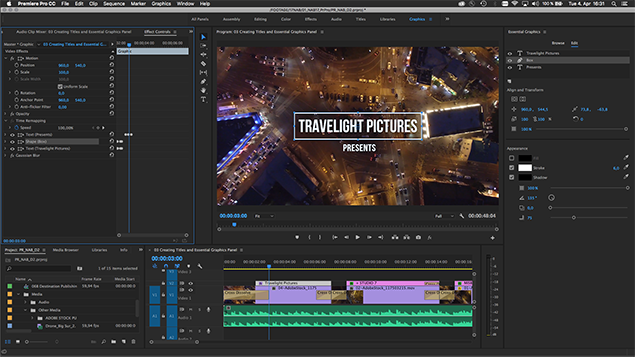
Motion Graphics templates: Editors can create and save Motion Graphic templates in Premiere Pro, including text, shape and clip layers. Compositions created in After Effects and saved as Motion Graphics templates allow editors to change variables such as text, color, size, layout or mood of the motion graphics -- all within Premiere Pro. To work with Motion Graphics templates created in After Effects in Premiere Pro, After Effects (trial/license) must be installed. Templates can easily be shared via CC Libraries and archived in the Media Browser for easy access.
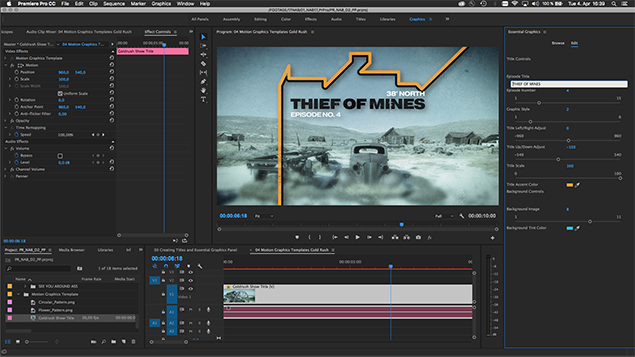
Essential Sound panel: As video production schedules get shorter and budgets get smaller, editors often need to achieve professional-quality sound on their own. The Essential Sound panel is now available in both Premiere Pro and Audition. It provides an intuitive, powerful audio editing experience focused on creative intent, without requiring audio engineering expertise. Users can easily assign mix types to their clips, identifying the role each clip plays in the project: dialogue, music, or sound effects. The panel then exposes effects, sliders, and tools appropriate for that type of content. For example, dialogue clips can be analyzed and set to a uniform loudness, have background noise or interference reduced, and add compression and EQ for improved clarity using simple sliders and options.
Environmental sounds can also be adjusted to add a greater depth and space.
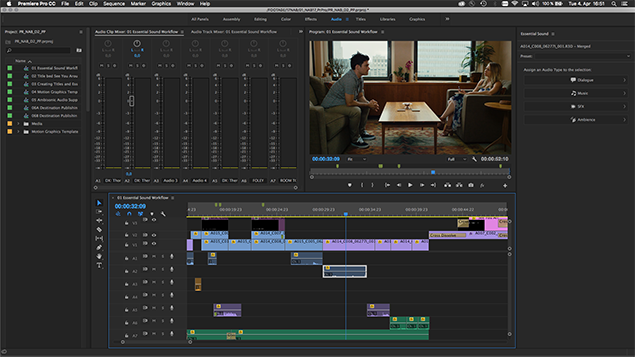
Audio effects & improved integration with Adobe Audition: Editors working with audio effects now have more choices within Premiere Pro. Among the many new effects, editors can use Convolution Reverb, which records a clip and applies the acoustics to a different recording to make it sound like it was recorded in the same environment, and a DeEsser which reduces sibilants and hard "s" sounds in recorded dialogue. Other audio effects have been updated to include real-time spectral displays and meters. All audio effects and keyframes transfer smoothly over to Audition without the need for intermediate rendering for an efficient, seamless audio workflow.
Ambisonic audio for VR: Expanding on its best-in-class native support for VR, Premiere Pro now supports ambisonic audio export, enriching the VR experience with positionally-aware audio for VR enabled platforms like YouTube and Facebook.
Adobe After Effects
Essential Graphics Panel: Build lower-third titles, brand identities or other graphics as Motion Graphics templates for Premiere Pro. Retain stylistic control of your motion graphics and save access frequently-used properties when designing and versioning motion graphics compositions. Define the adjustment properties available to Premiere Pro users in your Motion Graphics templates such as text, color, opacity, and other values. Motion Graphics templates make it simple to ensure visual consistency in collaborative workflows and can be saved and shared easily via Creative Cloud Libraries.
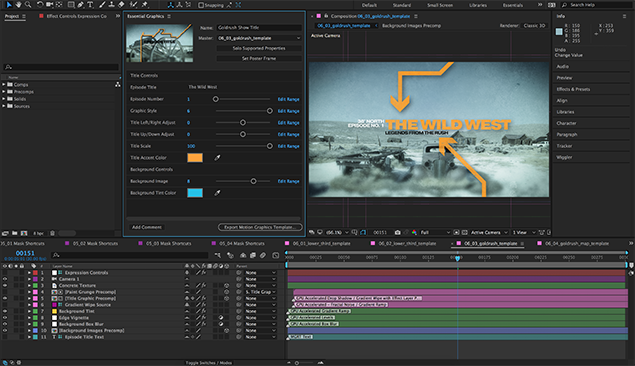
Camera Shake Deblur: When camera movement produces unwanted motion blurred artifacts, users will appreciate the power of Camera Shake Deblur. When combined with the Warp Stabilizer VFX, the new effect salvages otherwise unusable shots due to camera bumps or undesirable motion blur that can remain when using stabilization tools. The new effect reduces motion blur by analyzing frames on either side of the selected frame to identify apparent sharpness and then uses optical flow technology to apply the sharp frames onto the blurred frames.
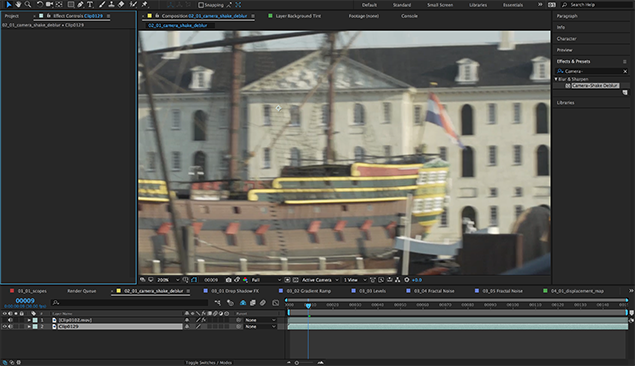
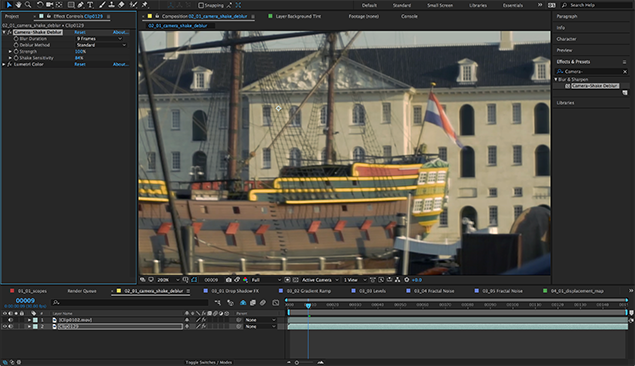
Lumetri Scopes: Apply accurate color adjustment to compositions with the aid of integrated Lumetri Scopes. As in Premiere Pro, the Lumetri Scopes panel displays resizable video scopes: Vectorscopes, Histogram, Parade, and Waveform, that help evaluate and color-correct clips. Display up to five scopes in the Lumetri Scopes panel and select 8-bit, float, or HDR, depending on your preferences and the media you are working with.
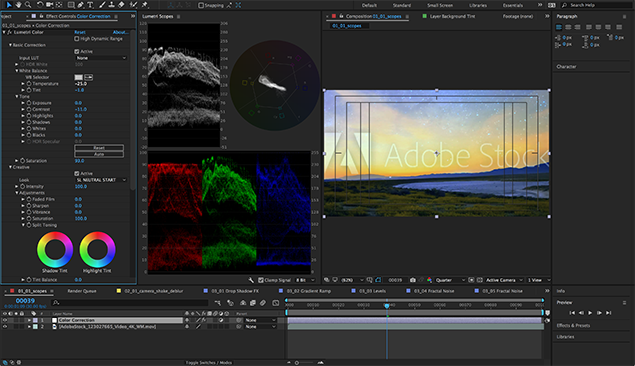
GPU-Accelerated effects and overall performance improvements: Render effects faster and get instant feedback on your creative choices. New to the GPU-accelerated effect list are Fractal Noise, Levels, and Fast Box Blur, giving you the classic look of Gaussian Blur (Legacy) and Fast Blur on the GPU. Also, get overall performance improvements under the hood.
Simplified effect organization: Simplify project organization by including source masks and effects when using a layer as an effect input. Effects that use layers as an input, such as Set Matte and Displacement Map, can now target the input layer’s masks and effects, instead of only the source of the layer. This means that for many cases you won’t need to pre-compose layers just for the purpose of being referenced by an effect.
Adobe Character Animator CC (Beta)
Walk Cycles: Create instant walking animations from a single profile pose simply by tagging your character’s legs, arms, and body. The new Walk behavior enables you to simulate various stride styles, like walk, run, and sneak, and automatically adapts to long or short legs and different step speeds. Walk in place or across the scene: your puppet’s feet stay planted at ground level to avoid sliding.
Viseme Editor: After recording or importing pre-recorded audio, view the various mouth shapes Character Animator has chosen for you in a separate audio track. Select, trim, delete, insert or replace individual mouth shapes via a simple right mouse click to select an alternative.
Live Streaming via Facebook and YouTube: Send your character to an external device or 2nd monitor using Mercury Transmit which supports both Mac or Windows. Plug-ins from manufacturers such as AJA, Blackmagic Design, Bluefish444, and Matrox, as well as IP-based technologies, such as the NewTek NDI protocol, that route video frames from Mercury Transmit to supported devices gives you the ability to broadcast your character on Facebook Live and YouTube streaming. Using multiple machines, you can output multiple puppets for a live production with animated characters that interact with each other -- or the audience -- in real time.
Blending Modes: Add visual interest to a puppet’s appearance by controlling how a layer interacts with the layers beneath it. Add highlights for eyes or shade body parts by choosing blending modes such as Overlay or Multiply.
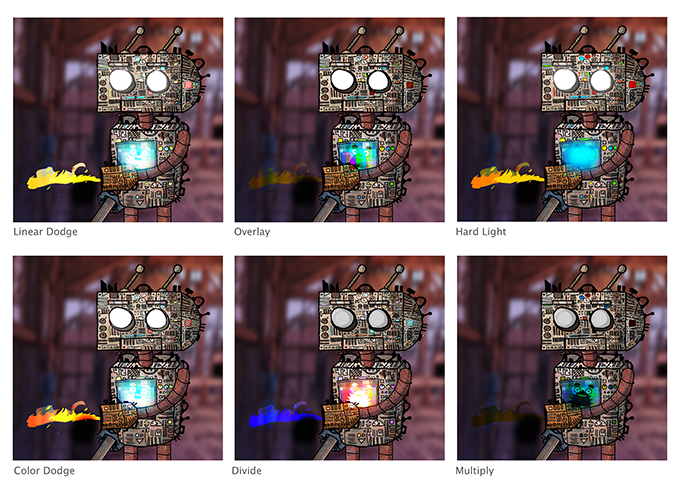
Workspaces: Move through the animation process step by step with new workspaces. The Start workspace provides interactive and video tutorials, puppet templates, helpful resources on the web, and commands for creating and opening your projects. Use the Rig workspace for editing the structure and capabilities of your puppet, such as adding and modifying behaviors, rearranging layers, adjusting keyboard triggers, and adding handles and sticks. The Record workspace is focused on capturing, reviewing, and fine-tuning puppet performances, using your webcam and keyboard controls. This is where you access the scene’s timeline, select different puppets to control or record, adjust the timing of puppets or recorded takes, and playback your performance. The Stream module helps bring everything together for polished live output.
Nutcracker Jaw Improvements: For simple animations without a lot of different mouth shapes, the Nutcracker Jaw has been improved to respond to the loudness of your voice. In addition, a wider range of jaw movements is now available.
Adobe Audition CC
Multichannel audio workflows: Break out multi-channel files into separate clips in Multitrack, or pick and choose custom channel configurations for new clips. From intelligent separation of standard formats like 5.1 or Ambisonics, to the unique MXF arrangements common with broadcast and video facilities, the new multichannel workflows save time and disk space.
Enhanced interchange with Premiere Pro CC: Get started in Premiere Pro and move easily into Audition, thanks to enhanced timeline fidelity. Expanded integration enables a unique workflow not possible with any other industry tools, including lossless transfer of native and third-party audio effect parameters and automation keyframes, track and submix routing, timeline metadata, and renderless Dynamic Link video streaming.
Visual Shortcut Editor: Audition now offers a visual keyboard shortcut editor, making it a breeze to find, modify, and create custom keyboard shortcuts for any command. Compatibility when using localized keyboards with different language installations means added flexibility for any workstation. New presets let Avid Pro Tools users keep familiar keyboard shortcuts when making the switch to Audition.
Presonus FaderPort controller support: Native support for the popular and powerful Presonus FaderPort hardware controller puts an inexpensive and responsive audio mixer on every desktop, while taking up less space than a mousepad. Adjust volume, pan, mute, solo, track selection, and automation at the touch of a button. Control playback with the ergonomic transport controls, and automate workflows with the user-assignable buttons that can be mapped to any Audition command or recorded Favorite.
Updated effects: New and updated audio effects across Audition and Premiere Pro provide parity across both apps, making it easy for users to move between the two. Many existing audio effects now have spectrum meters, gain meters, and gain reduction meters for improved visibility into audio adjustments.
Adobe Media Encoder
Team Projects (beta) support: Adobe Media Encoder allows you to browse Team Projects in the Media Browser and encode media in a Team Project such as file media, Premiere Pro sequences and After Effects compositions, directly in Adobe Media Encoder.
And more: Support for Color Profiles from After Effects sources are now available while giving you the option to relink assets in sequences. Render while you continue to work in Premiere Pro and leverage streamlined bit depth and alpha channel settings.
---
Adobe is making all these updates available immediately, rather than what we are used to with just seeing them teased at NAB and sent out later. You can download all these new features in the latest version of Creative Cloud, starting today.